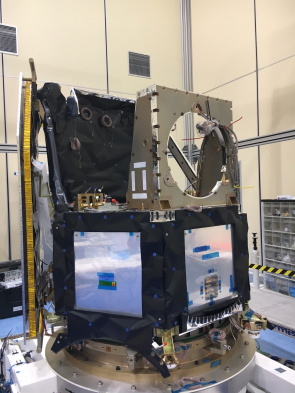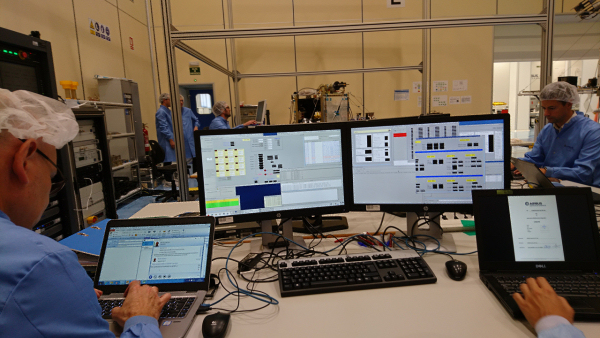#10: It's getting real: testing flight hardware with mission control code
18 December 2017
With the flight models of the CHEOPS spacecraft and telescope maturing, crucial tests can now be run with real hardware in place of simulations. The latest such tests involved operating the payload with the Mission Control System to test and validate real operational command sequences. |
| Simulating stars in the cleanroom. Credit: Airbus DS Space, Madrid |
In the field of space engineering, not everything that is essential is glamourous. When a missing minus sign in a single line of software could have irreparable consequences, system engineers need to be meticulous. A determined team of CHEOPS engineers has been hard at work to ensure that a complex ensemble of subsystems work together to deliver precious science data.
In September, another step on the path towards launch was taken when the CHEOPS spacecraft platform began relaying instructions to a model of the scientific instrument at Airbus Defence and Space - Spain in Madrid. While the flight model of the instrument was under construction over a thousand kilometres away in Bern, tests aimed at preparing for its integration with the spacecraft platform were conducted using an engineering model of the detector and electronics hardware.
 |
| Side view of the CHEOPS spacecraft platform. Credit: ADS–Spain |
The aim of these tests was to ensure that all procedures requiring communication between the spacecraft platform and the telescope instrument will execute flawlessly. These procedures include capturing images, generating housekeeping data, such as the so-called 'heartbeat report' that lets operators know that the instrument is still operational, and executing an attitude control loop to keep CHEOPS locked onto a target star.
For accurately measuring the radii of transiting exoplanets, the instrument is designed to have a pointing error of less than 8 arcseconds of jitter during a 48-hour observation, equivalent to an Olympic archer keeping a steady aim at the bullseye from a distance of over 3 kilometres. The attitude of the spacecraft will routinely be sensed by two star trackers; however, during long observations, the attitude of the orbiting spacecraft relative to the Sun will change, resulting in variations in how the structure is heated. This in turn will cause small thermo-elastic deformations of the telescope structure inducing a varying offset between the line of sight of the telescope and the attitude sensed by the star trackers. To correct for this subtle effect, the onboard Attitude and Orbit Control System (AOCS) uses the centroid of the target star as provided by the instrument and, if the centroid position moves, it instructs the spacecraft to correct the pointing drift with fine adjustments that keep the star centred in the image.
Testing this control loop involved providing a set of simulated images to the control system and monitoring the reaction of the control algorithms carefully. As every maths student or anyone who has ever had to write a computer programme knows, in a long sequence of calculations, errors can easily result from misplaced positive or negative signs, and, since the AOCS control loop involves a series of sub-units using particular sign conventions for positive and negative changes, dedicated tests were required to verify that the correct sign conventions have been applied throughout the control chain.
Other preparatory work has focussed on improvements to ground-based software systems.
At the Mission Operations Centre in Torrejón, an updated spacecraft simulator has allowed the engineers to test and debug an improved set of control tools. The simulator receives commands from the Mission Control System (MCS) software and reacts as the spacecraft would in orbit, sending back simulated data.
Development of the MCS is now entering the final phase and the Flight Dynamics System that is used for planning orbital manoeuvres and predicting orbital events, such as ground station visibility, has also been tested with the improved spacecraft simulator.
Dedicated software tools are not only required for controlling the spacecraft – new tools for scheduling observations, and processing and archiving science data are also in development at the Science Operations Centre in Geneva, which was recently put through its paces in its first acceptance test.
 |
| Controlling the CHEOPS instrument during interface testing. Credit: Airbus DS Space, Madrid |
Once the updated mission control software was in place and the interface between the spacecraft platform and the instrument had been tested, as described above, the next step was to operate the science instrument from the Mission Operations Centre (MOC), by relaying commands via the spacecraft platform. In CHEOPS journal #8, we reported on the second CHEOPS System Validation Test, SVT-1A, which took place in June and tested the operation of the spacecraft from the MOC. The latest System Validation Test, SVT-1B, took place in November and was similar to SVT-1A, but involved operations of the telescope payload, rather than the spacecraft platform. The tests allowed the MCS to interface with the real spacecraft hardware, instead of a simulator and the carefully prepared set of operational control sequences could finally be validated with confidence.
The successful test campaign means that the team can look ahead to SVT-2, which will involve the end-to-end testing of the CHEOPS nominal operations scenario, including iterations with the Science Operations Centre in Geneva.
Step by step, test by test, the CHEOPS engineers move the mission steadily forward, subjecting all procedures to careful scrutiny so that the quality and quantity of the scientific data is optimised.
About CHEOPS
CHEOPS is an ESA mission implemented in partnership with Switzerland, through the Swiss Space Office (SSO). The University of Bern leads a consortium of 11 ESA Member States contributing to the mission and represented in the CHEOPS Science Team. ESA is the mission architect responsible for overall mission definition and procurement of the spacecraft and launch. ESA is also responsible for the early operations phase that will be executed by the spacecraft contractor, Airbus Defence and Space – Spain. The science instrument is led by the University of Bern, with important contributions from Austria, Belgium, Germany and Italy. Other contributions to the science instrument, in the form of hardware or science operations, are provided by Hungary, France, Portugal, Sweden, and the United Kingdom. CHEOPS will be launched from Europe's spaceport in Kourou, French Guiana, on a Soyuz rocket operated by Arianespace. Following successful in-orbit commissioning of the spacecraft, responsibility for operations will be taken over by the CHEOPS Mission Consortium, with the Mission Operations Centre under the responsibility of INTA, Spain, and the Science Operations Centre led by the University of Geneva, Switzerland.




